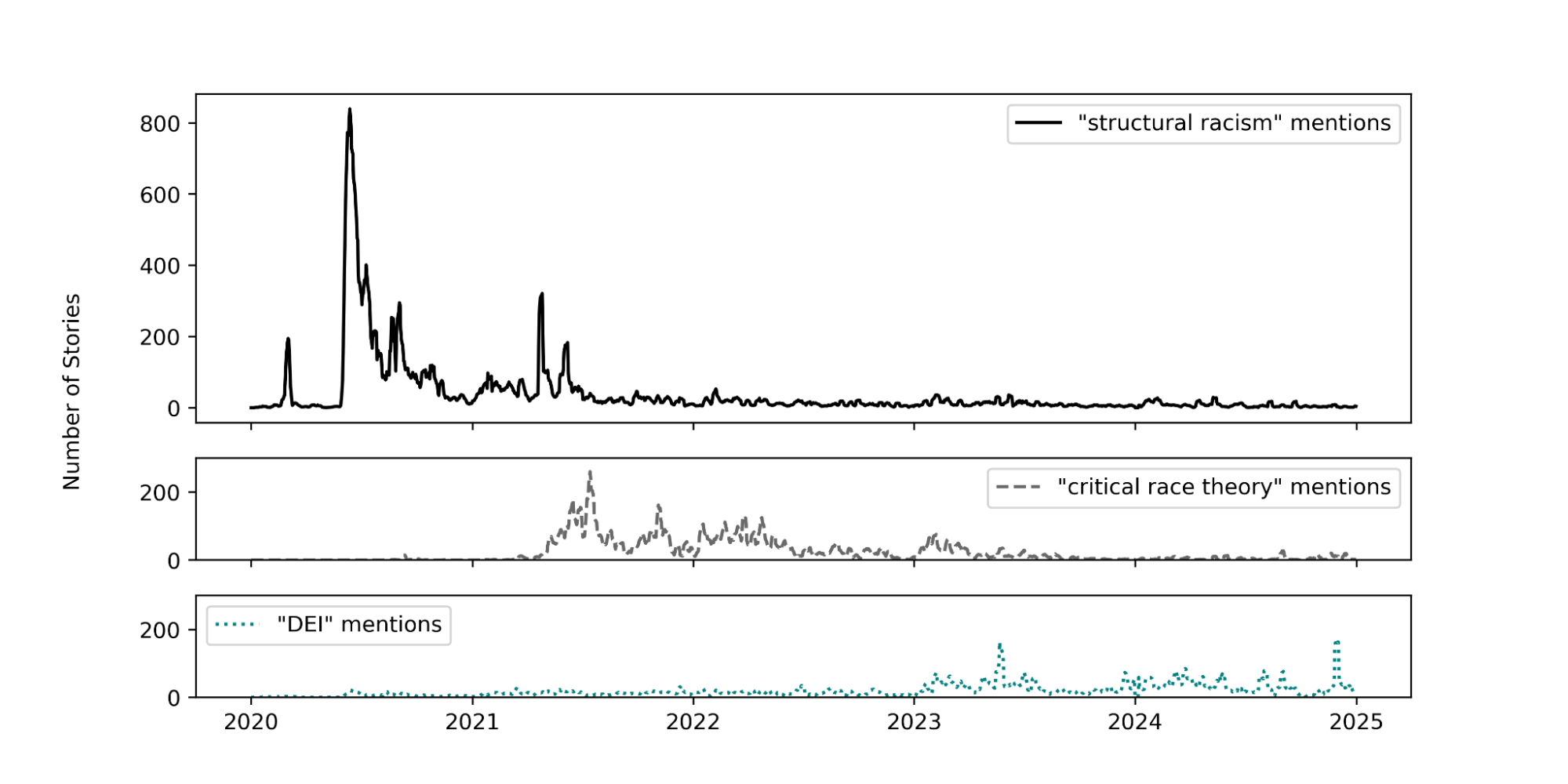Attention to, Predictors of, and Potential Consequences of Racism and Counter-Messaging in Mainstream Media
Brief Report, January 2025
As shown in Figure 1 below, although political attention to and media discussion of structural racism explicitly rose dramatically in the summer of 2020 due to the combination of COVID-19 disparities and George Floyd’s murder making the topic salient, the subsequent four years did not sustain this attention. In fact, we uncover evidence not only that the discussion of structural racism has declined but also that there is rising attention to strategic counternarratives to bolster anti-equity initiatives in the forms of both the anti-critical race theory and anti-diversity equity and inclusion (DEI) discussion.
Figure 1 – Local media attention to racism, critical race theory and DEI initiatives. Trendlines are seven- day rolling averages.

Note: The y-axis for racism uses a different scale to accommodate its large magnitude.
At the same time, we have been tracking attention to race-related issues in campaign advertising in the 2024 presidential elections, following our assessment of the 2022 midterm messaging published in JHPPL. Although much of the 2024 campaign discourse in federal races revolved around kitchen table issues that included housing and cost of living, political advertising also continued the trend we identified in 2022 in which messaging from both parties frequently featured discussion of crime and immigration with prominent and negative racialized stereotypes. Critically, and also similar to 2022, in the 2024 campaign there was virtually no discussion of structural racism, racial equity, or social justice. In fact, the most prominent messenger explicitly using the term racism specifically was presidential hopeful and Trump nominee Vivek Ramaswamy and his superPAC, which ran more than 1,200 ad airings discussing how “reverse racism is racism.” Similar to the midterm cycle, to the extent that the race, racism and identity-related conversations were being led by a party, they were led by Republicans with the sole exception of discussion of women and abortion by Democrats. Further, the much discussed anti-trans advertising by the Trump campaign was actually a continuation and expansion of pro-Republican messaging that began in the 2022 midterms and was prominent in races throughout the country in 2024.
The message patterns we have uncovered are likely to undermine efforts to move public opinion in support of equity-enhancing policies. The discourse and stereotypes most readily available in the information environment would appear much more likely to reinforce partisan polarization and produce negative responses to efforts which seek to advance health equity because of the increased accessibility of negatively valenced stereotypes about people of color. In short, the message environment since 2020 has steadily moved away from one favorable to public understanding of the structural barriers to racial and health equity.
Acknowledgement
This work was funded by the Robert Wood Johnson Foundation (Grant # 79754). The views expressed here do not necessarily reflect the views of the Robert Wood Johnson Foundation.
Authors: Erika Franklin Fowler, Steven T. Moore, Meiqing Zhang, Natália de Paula Moreira, Breeze Floyd, Furkan Cakmak, Yujin Kim, Neil Lewis, Jr., Jeff Niederdeppe, and Sarah E. Gollust
Citation
Suggested Citation:
Fowler EF, Moore ST, Zhang M, de Paula Moreira N, Floyd B, Cakmak F, Kim Y, Lewis N Jr, Niederdeppe J, Gollust SE. Attention to, predictors of, and potential consequences of racism and countermessaging in mainstream media. January 2025. Available from: https://commhsp.org/attention-to-predictors-of-and-potential-consequences-of-racism-and-counter-messaging-in-mainstream-media/